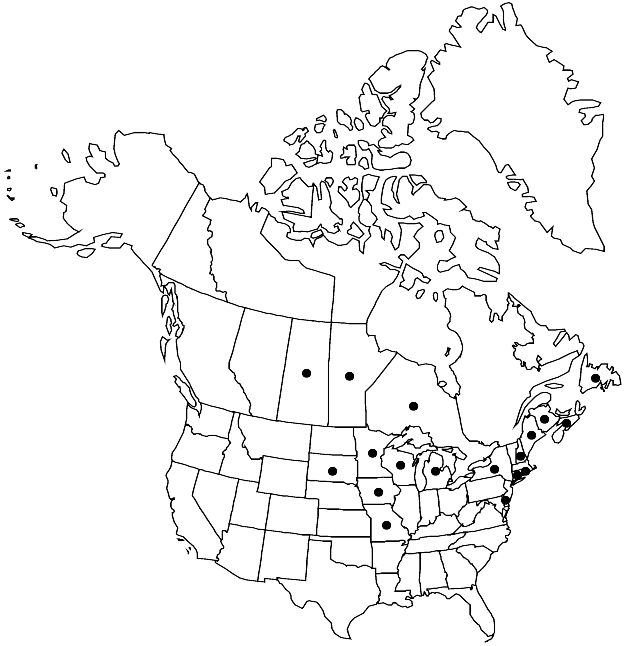Difference between revisions of "Brachythecium campestre"
in P. Bruch and W. P. Schimper, Bryol. Europ. 6: 16. 1853.
FNA>Volume Importer |
FNA>Volume Importer |
||
| Line 14: | Line 14: | ||
|name=Brachythecium calcareum | |name=Brachythecium calcareum | ||
|authority=Müller Hal. & Kindberg | |authority=Müller Hal. & Kindberg | ||
| − | }}{{Treatment/ID/Synonym | + | }} {{Treatment/ID/Synonym |
|name=B. leucoglaucum | |name=B. leucoglaucum | ||
|authority=unknown | |authority=unknown | ||
| Line 31: | Line 31: | ||
|elevation=low to moderate elevations (10-500 m) | |elevation=low to moderate elevations (10-500 m) | ||
|distribution=Man.;N.B.;Nfld. and Labr. (Nfld.);N.S.;Ont.;Sask.;Conn.;Del.;Iowa;Maine;Mich.;Minn.;Mo.;N.H.;N.Y.;R.I.;S.Dak.;Wis.;Eurasia. | |distribution=Man.;N.B.;Nfld. and Labr. (Nfld.);N.S.;Ont.;Sask.;Conn.;Del.;Iowa;Maine;Mich.;Minn.;Mo.;N.H.;N.Y.;R.I.;S.Dak.;Wis.;Eurasia. | ||
| − | |discussion=<p>A. J. Grout (1928–1940, vol. 3) and H. A. Crum and L. E. Anderson (1981) expressed some doubts on the status of Brachythecium campestre and its clear differentiation from B. salebrosum. However, B. salebrosum seems absent or at least rare in eastern North America (except probably the more northern regions of eastern Canada). The vast majority of collections referred to B. salebrosum in eastern North America belong to B. acutum, B. campestre, B. rotaeanum, and other species. There are some differences between European and American B. campestre; if further studies provide additional evidence for their separation, then the American populations should be called B. leucoglaucum; for typification of this name and discussion on this species, see M. S. Ignatov et al. (2008). The diagnostic characters of B. campestre include the usually light green to whitish color, ovate-lanceolate leaves that are rather crumply plicate when optimally developed, alar cells in small to large groups of rather small and subquadrate cells, and, usually, a minutely rough seta.</p> | + | |discussion=<p>A. J. Grout (1928–1940, vol. 3) and H. A. Crum and L. E. Anderson (1981) expressed some doubts on the status of <i>Brachythecium campestre</i> and its clear differentiation from <i>B. salebrosum</i>. However, <i>B. salebrosum</i> seems absent or at least rare in eastern North America (except probably the more northern regions of eastern Canada). The vast majority of collections referred to <i>B. salebrosum</i> in eastern North America belong to <i>B. acutum</i>, <i>B. campestre</i>, <i>B. rotaeanum</i>, and other species. There are some differences between European and American <i>B. campestre</i>; if further studies provide additional evidence for their separation, then the American populations should be called B. leucoglaucum; for typification of this name and discussion on this species, see M. S. Ignatov et al. (2008). The diagnostic characters of <i>B. campestre</i> include the usually light green to whitish color, ovate-lanceolate leaves that are rather crumply plicate when optimally developed, alar cells in small to large groups of rather small and subquadrate cells, and, usually, a minutely rough seta.</p> |
|tables= | |tables= | ||
|references= | |references= | ||
| Line 54: | Line 54: | ||
|publication year=1853 | |publication year=1853 | ||
|special status= | |special status= | ||
| − | |source xml=https://jpend@bitbucket.org/aafc-mbb/fna-data-curation.git/src/ | + | |source xml=https://jpend@bitbucket.org/aafc-mbb/fna-data-curation.git/src/8f726806613d60c220dc4493de13607dd3150896/coarse_grained_fna_xml/V28/V28_648.xml |
|genus=Brachythecium | |genus=Brachythecium | ||
|species=Brachythecium campestre | |species=Brachythecium campestre | ||
Revision as of 17:07, 18 September 2019
Plants medium-sized to large, in moderately dense mats, light green, yellow-green, or whitish stramineous. Stems to 7 cm, creeping, terete-foliate, irregularly pinnate, branches to 8 mm, straight to slightly curved, terete-foliate. Stem leaves erect, loosely appressed, loosely imbricate, narrowly ovate-triangular or ovate-lanceolate, broadest at 1/9–1/7 leaf length, sometimes almost at costa insertion, concave, plicate, plicae usually parallel in falcate leaves, often shallow and uneven in straight leaves, giving some leaves a crumply appearance, 1.5–2.6 × 0.5–1.2 mm; base rounded, broadly short-decurrent; margins partly plane, recurved in many places, serrulate to serrate in acumen, occasionally almost entire, variable within one shoot; apex gradually tapered or acuminate; costa to 40–70% leaf length, moderately strong, small terminal tooth sometimes present; alar cells subquadrate or short-rectangular, same size as or smaller than basal cells, 15–25 × 11–13 µm, walls thick, region ± clearly delimited, 4–9 × 4–7 cells; laminal cells linear, (30–)60–100(–110) × 6–9 µm; basal cells to 20–40 × 10–15 µm, region in 1–3 rows, not markedly different from more distal cells. Branch leaves often falcate-secund; alar region conspicuous, pellucid, triangular. Sexual condition autoicous. Seta orange-brown to dark brown with age, 2–2.5 cm, rough or occasionally smooth. Capsule inclined to horizontal, dark brown, elongate, curved, 2 mm; annulus separating by fragments; operculum conic. Spores 15–19 µm.
Habitat: Soil, wooded areas, limestone, concrete blocks, tree trunks
Elevation: low to moderate elevations (10-500 m)
Distribution

Man., N.B., Nfld. and Labr. (Nfld.), N.S., Ont., Sask., Conn., Del., Iowa, Maine, Mich., Minn., Mo., N.H., N.Y., R.I., S.Dak., Wis., Eurasia.
Discussion
A. J. Grout (1928–1940, vol. 3) and H. A. Crum and L. E. Anderson (1981) expressed some doubts on the status of Brachythecium campestre and its clear differentiation from B. salebrosum. However, B. salebrosum seems absent or at least rare in eastern North America (except probably the more northern regions of eastern Canada). The vast majority of collections referred to B. salebrosum in eastern North America belong to B. acutum, B. campestre, B. rotaeanum, and other species. There are some differences between European and American B. campestre; if further studies provide additional evidence for their separation, then the American populations should be called B. leucoglaucum; for typification of this name and discussion on this species, see M. S. Ignatov et al. (2008). The diagnostic characters of B. campestre include the usually light green to whitish color, ovate-lanceolate leaves that are rather crumply plicate when optimally developed, alar cells in small to large groups of rather small and subquadrate cells, and, usually, a minutely rough seta.
Selected References
None.